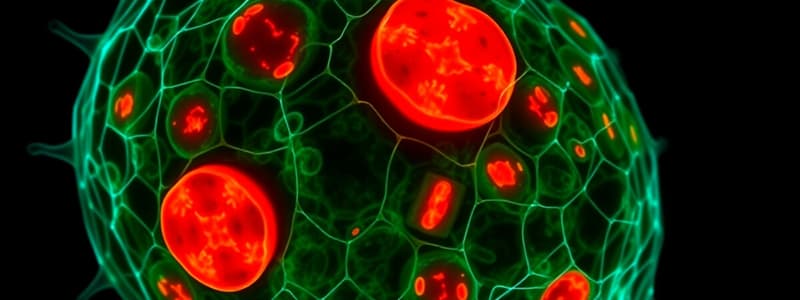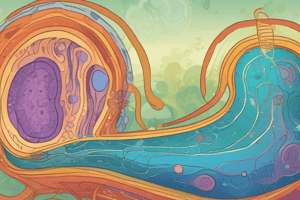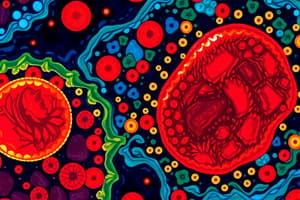Podcast
Questions and Answers
What is the primary component of the mitochondrial genome?
What is the primary component of the mitochondrial genome?
- Linear DNA molecules
- Circular DNA molecules (correct)
- Chromosomal DNA
- RNA molecules
How many proteins does the human mitochondrial genome encode that are involved in electron transport and oxidative phosphorylation?
How many proteins does the human mitochondrial genome encode that are involved in electron transport and oxidative phosphorylation?
- 13 (correct)
- 16
- 8
- 10
Which type of genes encode the proteins necessary for transcription and translation in mitochondria?
Which type of genes encode the proteins necessary for transcription and translation in mitochondria?
- Plasmid genes
- Nuclear genes (correct)
- Mitochondrial genes
- Cytoplasmic genes
What is the size of the human mitochondrial genome?
What is the size of the human mitochondrial genome?
Where are mitoribosomal proteins (MRPs) synthesized?
Where are mitoribosomal proteins (MRPs) synthesized?
What is the complete mitoribosome complex called?
What is the complete mitoribosome complex called?
Which mitochondrial structure interacts with the translocase OXA1L?
Which mitochondrial structure interacts with the translocase OXA1L?
What is primarily encoded by the mitochondrial genome apart from proteins?
What is primarily encoded by the mitochondrial genome apart from proteins?
What is the main goal of mitochondrial replacement techniques?
What is the main goal of mitochondrial replacement techniques?
How many proteins are estimated to be encoded by the nuclear genome for mammalian mitochondria?
How many proteins are estimated to be encoded by the nuclear genome for mammalian mitochondria?
What is the primary function of the Tom complex?
What is the primary function of the Tom complex?
Which sequence is crucial for directing proteins to the mitochondrial matrix?
Which sequence is crucial for directing proteins to the mitochondrial matrix?
What process converts glucose into pyruvate in animal cells?
What process converts glucose into pyruvate in animal cells?
What role does the electrochemical potential play in mitochondrial protein import?
What role does the electrochemical potential play in mitochondrial protein import?
What is the primary role of the enzymes within the citric acid cycle?
What is the primary role of the enzymes within the citric acid cycle?
Which process is NOT associated with mitochondrial replacement techniques?
Which process is NOT associated with mitochondrial replacement techniques?
Which protein complex is responsible for transferring proteins to the inner membrane of mitochondria?
Which protein complex is responsible for transferring proteins to the inner membrane of mitochondria?
Which of the following statements about the inner mitochondrial membrane is true?
Which of the following statements about the inner mitochondrial membrane is true?
How is the energy used for ATP synthesis generated during oxidative phosphorylation?
How is the energy used for ATP synthesis generated during oxidative phosphorylation?
Which of the following describes the structure of mammalian mitochondria?
Which of the following describes the structure of mammalian mitochondria?
What is the fate of pyruvate after glycolysis?
What is the fate of pyruvate after glycolysis?
Which type of molecules can freely pass through the outer mitochondrial membrane?
Which type of molecules can freely pass through the outer mitochondrial membrane?
What type of relationship is believed to have led to the evolution of mitochondria?
What type of relationship is believed to have led to the evolution of mitochondria?
Which statement correctly describes the fate of the high-energy electrons from NADH and FADH2?
Which statement correctly describes the fate of the high-energy electrons from NADH and FADH2?
What is the primary function of mitochondria in cells?
What is the primary function of mitochondria in cells?
What unique feature do mitochondria possess that distinguishes them from peroxisomes?
What unique feature do mitochondria possess that distinguishes them from peroxisomes?
How are most mitochondrial proteins synthesized?
How are most mitochondrial proteins synthesized?
What structural feature increases the surface area of the inner mitochondrial membrane?
What structural feature increases the surface area of the inner mitochondrial membrane?
What is the role of enzymes contained within peroxisomes?
What is the role of enzymes contained within peroxisomes?
Which compartments of mitochondria are primarily involved in oxidative metabolism?
Which compartments of mitochondria are primarily involved in oxidative metabolism?
What process describes the dynamic changes in mitochondria as they fuse and divide?
What process describes the dynamic changes in mitochondria as they fuse and divide?
What type of genetic material is found within the mitochondrial matrix?
What type of genetic material is found within the mitochondrial matrix?
What is the primary role of cardiolipin in the mitochondria?
What is the primary role of cardiolipin in the mitochondria?
Which statement about peroxisomes is correct?
Which statement about peroxisomes is correct?
How are lipids transferred from the ER to the mitochondria?
How are lipids transferred from the ER to the mitochondria?
What distinguishes the enzymes found in peroxisomes from those in mitochondria?
What distinguishes the enzymes found in peroxisomes from those in mitochondria?
What is produced as a result of oxidative reactions in peroxisomes?
What is produced as a result of oxidative reactions in peroxisomes?
Which of the following is NOT a characteristic of peroxisomes?
Which of the following is NOT a characteristic of peroxisomes?
Cardiolipin is classified as which type of lipid?
Cardiolipin is classified as which type of lipid?
Which structure in the cell is responsible for the synthesis of phospholipids that may end up in the mitochondrial membranes?
Which structure in the cell is responsible for the synthesis of phospholipids that may end up in the mitochondrial membranes?
What is the primary function of catalase in peroxisomes?
What is the primary function of catalase in peroxisomes?
Which two signals are used for the targeting of internal peroxisomal proteins?
Which two signals are used for the targeting of internal peroxisomal proteins?
Which of the following is NOT involved in the import of matrix proteins into peroxisomes?
Which of the following is NOT involved in the import of matrix proteins into peroxisomes?
What is a key function of plasmalogens formed in peroxisomes?
What is a key function of plasmalogens formed in peroxisomes?
How are most transmembrane proteins for peroxisomes synthesized?
How are most transmembrane proteins for peroxisomes synthesized?
Which peroxin is specifically involved in recognizing the PTS1 signal?
Which peroxin is specifically involved in recognizing the PTS1 signal?
What is one of the mechanisms through which new peroxisomes can form?
What is one of the mechanisms through which new peroxisomes can form?
Which of the following components are recognized by Pex19 during the import of peroxisomal membrane proteins?
Which of the following components are recognized by Pex19 during the import of peroxisomal membrane proteins?
Flashcards
Oxidative Phosphorylation
Oxidative Phosphorylation
The process of converting energy from the breakdown of carbohydrates and fatty acids into ATP.
Mitochondrial cristae
Mitochondrial cristae
The inner membrane of the mitochondria folds inwards, creating the cristae which increase surface area for oxidative phosphorylation.
Mitochondrial matrix
Mitochondrial matrix
The fluid-filled space within the inner membrane of the mitochondria.
Mitochondrial Fusion and Fission
Mitochondrial Fusion and Fission
Signup and view all the flashcards
Mitochondrial protein import
Mitochondrial protein import
Signup and view all the flashcards
Mitochondrial DNA
Mitochondrial DNA
Signup and view all the flashcards
Mitochondrial Membranes
Mitochondrial Membranes
Signup and view all the flashcards
Mitochondrial Diseases
Mitochondrial Diseases
Signup and view all the flashcards
Glycolysis
Glycolysis
Signup and view all the flashcards
Citric Acid Cycle (Krebs Cycle)
Citric Acid Cycle (Krebs Cycle)
Signup and view all the flashcards
Electron Transport Chain
Electron Transport Chain
Signup and view all the flashcards
Oxidative Metabolism
Oxidative Metabolism
Signup and view all the flashcards
Inner Mitochondrial Membrane
Inner Mitochondrial Membrane
Signup and view all the flashcards
Outer Mitochondrial Membrane
Outer Mitochondrial Membrane
Signup and view all the flashcards
Endosymbiosis
Endosymbiosis
Signup and view all the flashcards
Protein Import into Mitochondria
Protein Import into Mitochondria
Signup and view all the flashcards
Tom Complex
Tom Complex
Signup and view all the flashcards
Tim23 Complex
Tim23 Complex
Signup and view all the flashcards
Electrochemical Potential in Mitochondrial Protein Import
Electrochemical Potential in Mitochondrial Protein Import
Signup and view all the flashcards
Transmembrane Proteins and the Tim23 Channel
Transmembrane Proteins and the Tim23 Channel
Signup and view all the flashcards
Leader Sequences for Mitochondrial Targeting
Leader Sequences for Mitochondrial Targeting
Signup and view all the flashcards
Presequences for Mitochondrial Targeting
Presequences for Mitochondrial Targeting
Signup and view all the flashcards
Mitochondrial Protein Synthesis
Mitochondrial Protein Synthesis
Signup and view all the flashcards
What is mtDNA?
What is mtDNA?
Signup and view all the flashcards
How much mtDNA is in each mitochondrion?
How much mtDNA is in each mitochondrion?
Signup and view all the flashcards
Where are most mitochondrial proteins encoded?
Where are most mitochondrial proteins encoded?
Signup and view all the flashcards
How does mtDNA size differ between species?
How does mtDNA size differ between species?
Signup and view all the flashcards
What is the main role of mtDNA encoded proteins?
What is the main role of mtDNA encoded proteins?
Signup and view all the flashcards
How do mitochondria translate their own proteins?
How do mitochondria translate their own proteins?
Signup and view all the flashcards
What role do nuclear genes play in mitochondrial function?
What role do nuclear genes play in mitochondrial function?
Signup and view all the flashcards
What are mitoribosomes made of?
What are mitoribosomes made of?
Signup and view all the flashcards
What are peroxisomes?
What are peroxisomes?
Signup and view all the flashcards
What is the role of catalase in peroxisomes?
What is the role of catalase in peroxisomes?
Signup and view all the flashcards
What are plasmalogens and where are they important?
What are plasmalogens and where are they important?
Signup and view all the flashcards
How do proteins get into peroxisomes?
How do proteins get into peroxisomes?
Signup and view all the flashcards
What is PTS1 and what is its role?
What is PTS1 and what is its role?
Signup and view all the flashcards
How are the PTS1 and PTS2 signals recognized by peroxisomes?
How are the PTS1 and PTS2 signals recognized by peroxisomes?
Signup and view all the flashcards
How are new peroxisomes formed?
How are new peroxisomes formed?
Signup and view all the flashcards
What is the role of Pex19 in peroxisome membrane protein import?
What is the role of Pex19 in peroxisome membrane protein import?
Signup and view all the flashcards
What is cardiolipin?
What is cardiolipin?
Signup and view all the flashcards
How do lipids get from the ER to mitochondria?
How do lipids get from the ER to mitochondria?
Signup and view all the flashcards
What are some key features of peroxisomes?
What are some key features of peroxisomes?
Signup and view all the flashcards
What are some of the functions of peroxisomes?
What are some of the functions of peroxisomes?
Signup and view all the flashcards
Describe the structure of peroxisomes.
Describe the structure of peroxisomes.
Signup and view all the flashcards
How are peroxisomes formed?
How are peroxisomes formed?
Signup and view all the flashcards
What is the difference between mitochondrial and peroxisomal proteins?
What is the difference between mitochondrial and peroxisomal proteins?
Signup and view all the flashcards
Study Notes
Mitochondria and Peroxisomes
- Mitochondria are responsible for generating most of the cell's usable energy from the breakdown of lipids and carbohydrates.
- Peroxisomes contain enzymes involved in various metabolic pathways, including fatty acid breakdown and photorespiration.
- Proteins destined for mitochondria and peroxisomes are synthesized on free ribosomes in the cytosol, except for membrane proteins of the peroxisome.
- Proteins import into target organelles, in the form of complete polypeptide chains.
- Mitochondria contain their own genomes, which include genes transcribed and translated within the organelle itself.
- Mitochondria are surrounded by a double membrane system, an inner and outer mitochondrial membrane separated by an intermembrane space
- The inner membrane folds into numerous cristae, which extend into the mitochondrial matrix
- The matrix and inner membrane are the primary functional compartments of mitochondria.
- Mitochondria are dynamic and undergo fusion and fission.
- The matrix contains mitochondrial genetic system and enzymes responsible for central reactions of oxidative metabolism.
- The primary source of metabolic energy involves the breakdown of glucose and fatty acids.
- The oxidation of acetyl CoA to CO2 is linked to the reduction of NAD+ and FAD to NADH and FADH2, respectively.
- Most energy from oxidative metabolism is produced by oxidative phosphorylation in the inner mitochondrial membrane.
- High-energy electrons from NADH and FADH2 are transferred to oxygen via membrane transporters.
- The energy from electron transfer is converted into a proton gradient used to synthesize ATP.
- The inner mitochondrial membrane has high protein content, is involved in oxidative phosphorylation, and maintains a critical proton gradient.
- Outer membrane is completely permeable to small molecules via porins, which allow passage of molecules smaller than 1000 daltons.
- The composition of the intermembrane space is similar to that of the cytosol.
Genetic System of Mitochondria
- Mitochondria evolved from bacteria.
- Mitochondrial genome forms a circular DNA molecule and several copies per organelle.
- Size of the mitochondrial genome varies between different species.
- Mitochondrial DNA encodes essential components for oxidative phosphorylation (tRNA, rRNA, some proteins).
- Other mitochondrial proteins are encoded by nuclear genes and transferred from ancestral mitochondrial genomes.
- Human mitochondrial genome is only 16 kb, while yeast and plants have larger genomes
- Human mitochondrial genome codes for 13 proteins, 16S and 12S ribosomal RNA, and 22 transfer RNAs.
- Nuclear genes provide the rest of the proteins required for mitochondrial functions.
Mitochondrial Diseases
- Mitochondrial DNA mutations, primarily transmitted through the maternal line, are often harmful to the organelle.
- Mitochondrial inheritance means defects in mtDNA are inherited from the mother.
- Homoplasmy means the multiple copies of mitochondrial DNA in the cell are identical, while heteroplasmy means a combination of wild-type and mutated mitochondrial DNA.
Mitochondrial Protein Internalization and Formation
- Mammalian mitochondria contain about 1,500 proteins encoded by nuclear genome.
- Nuclear-encoded proteins are synthesized by free ribosomes in the cytoplasm and transported into mitochondria.
- Protein import is complex due to the double membrane of mitochondria.
- Proteins with amino terminal pre-sequences are the most studied.
- These pre-sequences bind to the Tom complex on the outer membrane for initial translocation.
- Mitochondrial matrix proteins cross the inner membrane via the Tim23-complex, utilizing the electrochemical gradient.
- Other proteins utilizing a transmembrane sequence laterally insert into the inner membrane via other transport mechanisms.
- Matrix proteases remove pre-sequences.
- Protein import through complex pathways in the matrix and inner membrane, necessitating chaperones
Peroxisomes
- Peroxisomes are small organelles (0.1-1 µm) with a membrane.
- Human cells have a variable number (100-1000) depending on activity.
- Peroxisomes lack a genome and utilize ribosomes in the cytoplasm for protein synthesis, while some proteins from the ER.
- Peroxisome function includes various metabolic reactions and protein synthesis.
- Peroxisomes are responsible for oxidation reactions that produce hydrogen peroxide.
- Catalase, a key peroxisomal enzyme, breaks down hydrogen peroxide.
- Peroxisomes oxidize branched and longer-chain fatty acids, along with other substrates.
- Peroxisomes participate in plasmalogen synthesis (important membrane component of heart and brain).
Peroxisome Assembly
- Internal peroxisomal proteins synthesize in the cytosol, while the bulk of transmembrane proteins are synthesized in the ER.
- Transmembrane proteins (peroxins, Pex proteins) are important for metabolite transport.
- PTS1 (Ser-Lys-Leu) signal, is widely used for proteins targeting peroxisomes.
- PTS2 (amino-terminal sequences of 9 aa) is another targeting designation.
- Peroxins (Pex5, Pex7, etc), as cytosolic receptors, bind to PTS1/PTS2 to initiate import to the peroxisome.
- The Pex complex anchors proteins to peroxisome membrane and helps them enter.
Lipid Transfer and Lipids in Peroxisomes
- Lipid transfer between ER and mitochondria happens at contact points and requires phospholipid transfer proteins to extract phospholipid molecules from ER and introduce them to the mitochondria.
- Lipids can then transport via an aqueous environment.
- Lipids move between the inner and outer mitochondrial membranes at contact points.
- The majority of lipids in the mitochondrial membranes originate from the cytosol and undergo synthesis in the ER.
- Phosphatidylethanolamine is produced from phosphatidylserine.
- Cardiolipin, a four fatty acid chain phospholipid, is synthesized in the inner membrane and enhances oxidative phosphorylation.
Studying That Suits You
Use AI to generate personalized quizzes and flashcards to suit your learning preferences.




